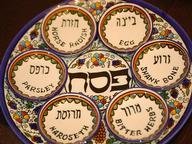Quiz Answer Key and Fun Facts
1. We start with Kadesh, the first part of the Passover Seder. As is the custom with many Jewish events and holidays, what happens during Kadesh?
2. Urchatz, the next part, means washing of the hands. Do we recite the traditional blessing over the washing of the hands at this point?
3. Karpas is the next thing that happens in the Passover Seder. As we recite the blessing "boreh pri ha-adamah", what do we consume?
4. The next step in the Passover Seder is yachatz. This is the breaking of the middle of the three pieces of matzah that are on the Seder table. What do we do with one of the halves of the broken matzah?
5. Maggid is a retelling of the story of Passover for all present to hear. It is tradition to allow everybody to participate so that they feel a part of the story. Which of the following is *not* part of the maggid?
6. Rachtzah is the next part of the Passover Seder. All assembled wash their hands, again... but do they say a blessing?
7. Motzi matzah is the part of the Passover Seder where the unleavened bread, matzah, replaces the regular bread, usually challah, in the ritual. Usually, the blessing is made over two challas, however, we have three matzahs on the table. Which matzah is eaten first after the blessings are made?
8. Maror is the bitterest of the parts of the Passover Seder. In fact, the word 'maror' actually means just that, 'bitter'. What is the maror dipped in at this point in the Seder?
9. The next part of the Passover Seder is korech, which is basically the 'sandwich station' of the ceremony. Here, one is instructed to take some matzah and put maror between the pieces, like a sandwich. Which famous Rabbi instructed this practice? [Hint: it wasn't Rabbi Shammai]
10. The next part of the Passover Seder is the shulchan orech, the festival meal. It is customary to start by eating a hard-boiled egg, dipped in salt water. What is the egg symbolic of?
11. Tzafun is the next part of the Passover Seder; the name means 'hidden'. What needs to be found for this part of the Seder to proceed?
12. Now, the Passover Seder has reached bareich, the blessing. For whom is a third cup of wine poured that traditionally visits every Seder?
13. The penultimate part of the Passover Seder is hallel, from whence the more familiar word 'hallelujah' comes. What is done at this part of the seder?
14. Nirtzah, the conclusion of the Passover Seder, is a simple enough recitation. One city is mentioned for all to keep at the forefront of their mind. Which city is mentioned?
Source: Author
LeoDaVinci
This quiz was reviewed by FunTrivia editor
looney_tunes before going online.
Any errors found in FunTrivia content are routinely corrected through our feedback system.
